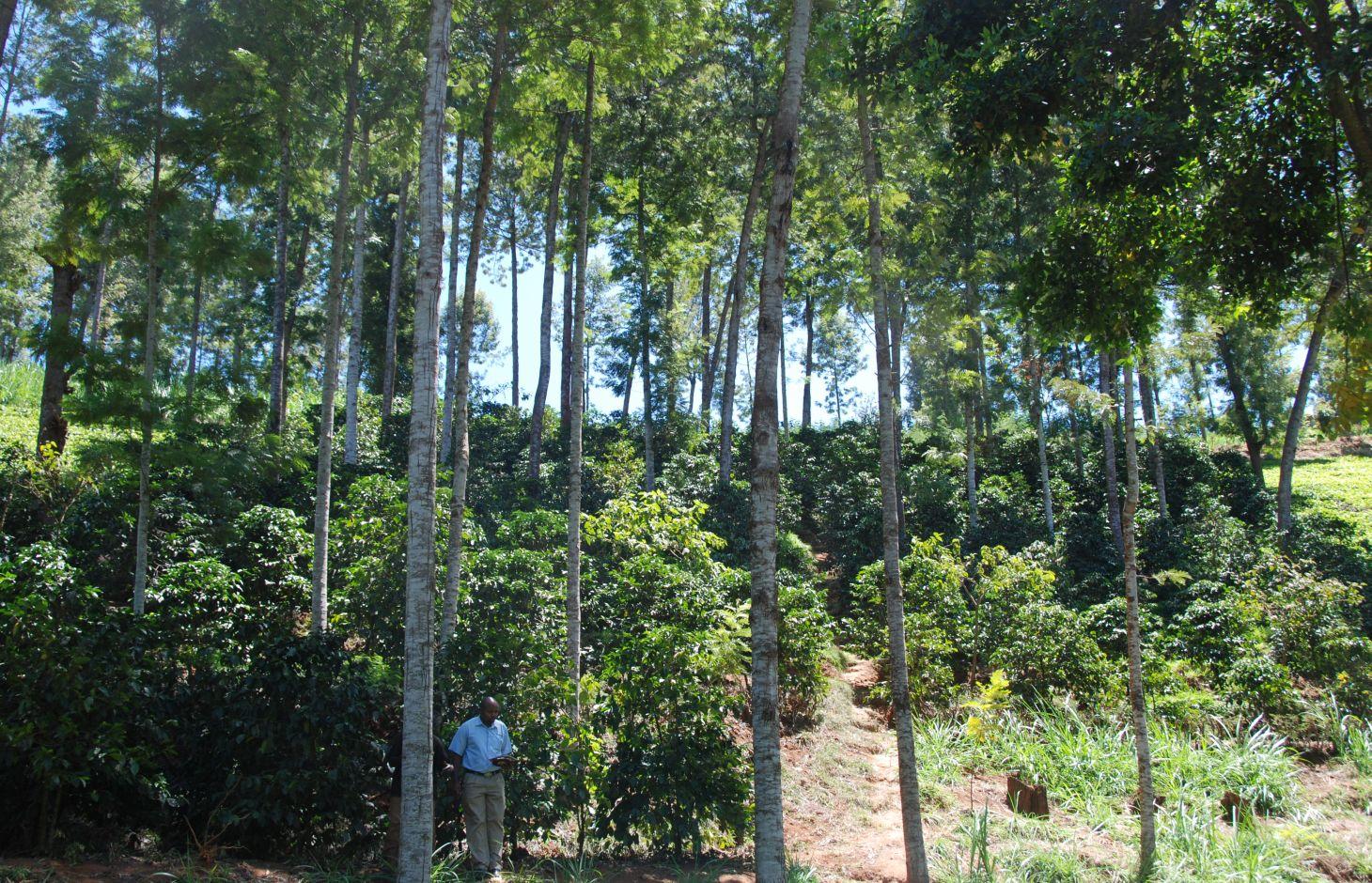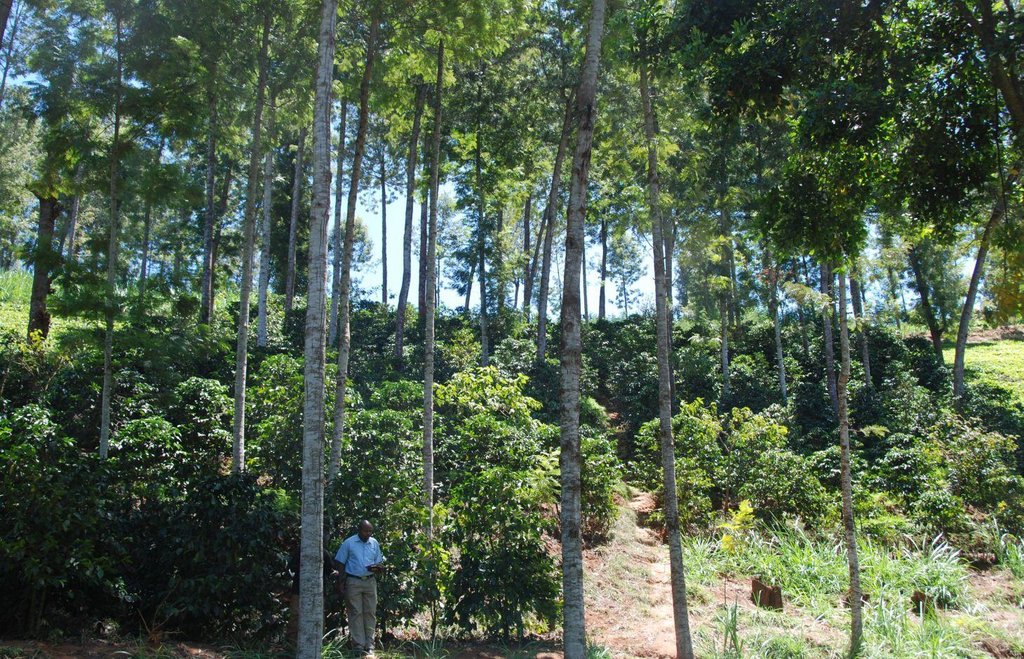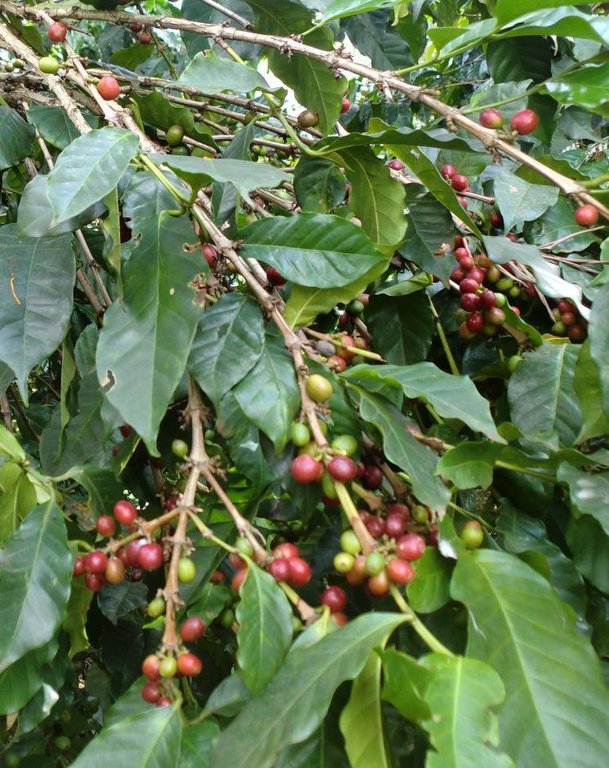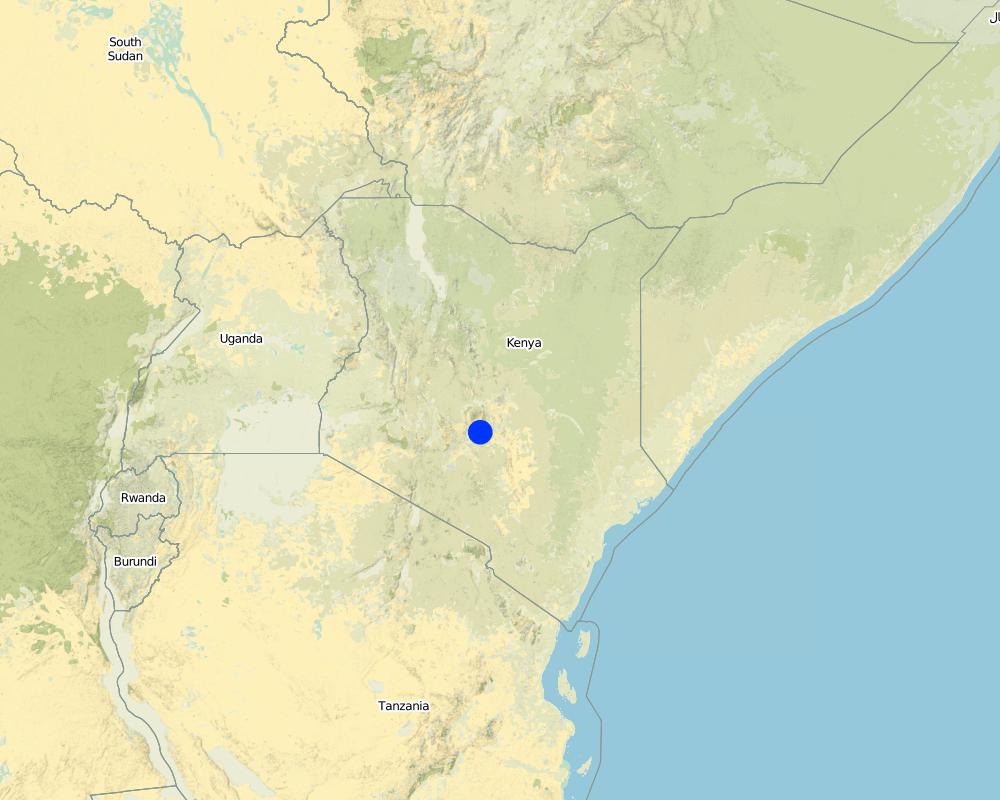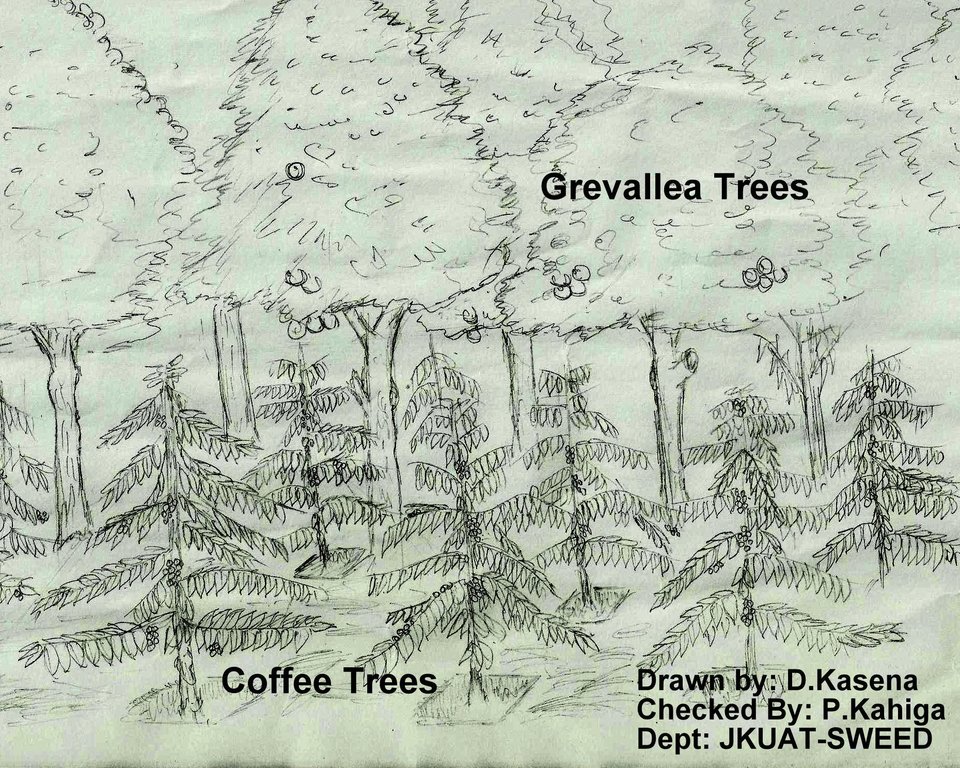Coffee Agroforestry [肯尼亚]
- 创建:
- 更新:
- 编制者: Paul Kahiga
- 编辑者: –
- 审查者: Fabian Ottiger, Alexandra Gavilano
Coffee Agroforetry
technologies_1212 - 肯尼亚
查看章节
全部展开 全部收起1. 一般信息
1.2 参与该技术评估和文件编制的资源人员和机构的联系方式
SLM专业人员:
Gathenya Mwangi
Jomo Kenyatta University of Agriculture and Technology
肯尼亚
SLM专业人员:
Home Patrick
Jomo Kenyatta University of Agriculture and Technology
肯尼亚
SLM专业人员:
Chege Timothy
Jomo Kenyatta University of Agriculture and Technology
肯尼亚
SLM专业人员:
Omwange Abamba
Jomo Kenyatta University of Agriculture and Technology
肯尼亚
SLM专业人员:
Kimengich Baobab
Jomo Kenyatta University of Agriculture and Technology
肯尼亚
SLM专业人员:
Wamuongo Jane
Kenya Agricultural Research Institute
肯尼亚
SLM专业人员:
Karanja Andrew
Kenya Agricultural Research Institute
肯尼亚
SLM专业人员:
Namirembe Sara
World Agroforestry Centre
肯尼亚
有助于对技术进行记录/评估的机构名称(如相关)
Jomo Kenyatta University (Jomo Kenyatta University) - 肯尼亚有助于对技术进行记录/评估的机构名称(如相关)
KARI Headquarters (KARI Headquarters) - 肯尼亚有助于对技术进行记录/评估的机构名称(如相关)
International Centre for Research in Agroforestry (ICRAF) - 肯尼亚1.3 关于使用通过WOCAT记录的数据的条件
编制者和关键资源人员接受有关使用通过WOCAT记录数据的条件。:
是
1.4 所述技术的可持续性声明
这里所描述的技术在土地退化方面是否存在问题,导致无法被认为是一种可持续的土地管理技术?:
否
2. SLM技术的说明
2.1 技术简介
技术定义:
Land use management system in which coffee is grown around or among crops or pastureland. It combines agricultural and forestry technologies to create more diverse, productive, profitable, healthy, and sustainable land-use systems.
2.2 技术的详细说明
说明:
The success of coffee agro-forestry depends on efficient use of available water and effective strategies to limit tree/crop competition and maximize productivity. On hillsides, planting improved tree/coffee fallows on the degraded upper section of bench terraces is a recommended practice to improve soil fertility while cropping continues on the lower terrace to maintain food production.
Purpose of the Technology: Fewer inputs and less labor required. Shade trees reduce alternate productions, thereby ensuring a more balanced income for coffee farmers. Timber and firewood production improves coffee farmer incomes. By spreading income over several crops, these systems are economically less risky than coffee
monoculture. Financial incentives for pilot projects helping to preserve biodiversity, soils and water quality can be applied, Bonuses are being considered for carbon sequestration in coffee plantations converted from a monoculture to an agroforestry system. The erosion of fragile mountain soils is reduced. Soil fertility is conserved. Exploitation of natural forest reserves is limited. Biological and faunistic diversity is safeguarded.
Establishment / maintenance activities and inputs: Agricultural intensification, moving along the gradient from agroforests grown with a diverse and dense shade canopy to those agroforests with only a few coffee trees to monocultures with only one crop species or cattle pastures, by definition includes a reduction in the planned biodiversity. Agricultural intensification also results in a loss of associated biodiversity. The following key studies in a range of agroforest types and other agricultural systems document losses in associated biodiversity (relative to nearby forest fragments) with increasing agricultural intensification.
Regular maintenance of the terraces through mulching to reduce erosion effects
Natural / human environment: In this technology, there is great intensive extension services through encouraging farmers to adopt it especially in open fields.
2.3 技术照片
2.5 已应用该技术的、本评估所涵盖的国家/地区/地点
国家:
肯尼亚
区域/州/省:
Eastern
有关地点的进一步说明:
Embu North
具体说明该技术的分布:
- 均匀地分布在一个区域
如果不知道精确的区域,请注明大致覆盖的区域:
- 1-10 平方千米
注释:
Most farmers are nor practicing Coffee Agro-forestry and the few practicing it are getting help of specialized people in the same and the agricultural extension officers fro Ministry of Agriculture (MoA)
Map
×2.6 实施日期
如果不知道确切的年份,请说明大概的日期:
- 10-50年前
2.7 技术介绍
详细说明该技术是如何引入的:
- 通过土地使用者的创新
3. SLM技术的分类
3.1 该技术的主要目的
- 改良生产
- 减少、预防、恢复土地退化
- 保护生态系统
- 适应气候变化/极端天气及其影响
- 创造有益的经济影响
3.2 应用该技术的当前土地利用类型
同一土地单元内混合使用的土地::
是
具体说明混合土地使用(作物/放牧/树木):
- 农林业

农田
- 一年一作
- 乔木与灌木的种植
乔木和灌木种植 - 指定作物:
- 咖啡,采树荫栽培
每年的生长季节数:
- 1

森林/林地
树木类型:
- 银桦
产品和服务:
- 木材
- 薪材
注释:
Major land use problems (compiler’s opinion): The effective soil conservation around the agricultural fields brought about by the coffee trees greatly improved land productivity.
Major land use problems (land users’ perception): There is increased yields because of better conservation practices
Future (final) land use (after implementation of SLM Technology): Cropland: Ca: Annual cropping
3.3 由于技术的实施,土地使用是否发生了变化?
由于技术的实施,土地使用是否发生了变化?:
- 是(请在技术实施前填写以下有关土地利用的问题)

农田
- 多年一作(非木材)
3.4 供水
该技术所应用土地的供水:
- 混合雨水灌溉
3.5 该技术所属的SLM组
- 农业林学
3.6 包含该技术的可持续土地管理措施

农艺措施
- A7:其它

结构措施
- S2:堤、岸
注释:
Specification of other agronomic measures: Coffee and Agroforestry trees
Type of agronomic measures: contour planting / strip cropping, mineral (inorganic) fertilizers, zero tillage / no-till
3.7 该技术强调的主要土地退化类型

土壤水蚀
- Wt:表土流失/地表侵蚀
注释:
Main causes of degradation: soil management, Heavy / extreme rainfall (intensity/amounts), land tenure, labour availability
3.8 防止、减少或恢复土地退化
具体数量名该技术与土地退化有关的目标:
- 防止土地退化
4. 技术规范、实施活动、投入和成本
4.1 该技术的技术图纸
技术规范(与技术图纸相关):
The technical drawing on the left hand side shows a stand of coffee trees planted with agro-forestry trees
Location: Embu. Eastern Province
Date: 13.12.2013
Technical knowledge required for field staff / advisors: moderate (In order to implement this technology, the farmers to contact the front line agricultural extension officers to assist in the correct spacing and planting of the coffee trees in the fields)
Technical knowledge required for land users: high (The planting of coffee trees requires a certain alignment, to avoid blocking of the young and growing crops.)
Main technical functions: control of raindrop splash
Secondary technical functions: reduction in wind speed
作者:
Paul Kahiga, 8444-00300 Nairobi - Kenya
4.3 技术建立活动
| 活动 | 时间(季度) | |
|---|---|---|
| 1. | Land preparation |
注释:
Life span of the land preparation: 3 years
4.4 技术建立所需要的费用和投入
| 对投入进行具体说明 | 单位 | 数量 | 单位成本 | 每项投入的总成本 | 土地使用者承担的成本% | |
|---|---|---|---|---|---|---|
| 劳动力 | Land preparation | ha | 1.0 | 50.0 | 50.0 | 100.0 |
| 设备 | Tools | ha | 1.0 | 70.0 | 70.0 | 100.0 |
| 植物材料 | Seedlings | ha | 1.0 | 500.0 | 500.0 | 100.0 |
| 肥料和杀菌剂 | Fertilizer | ha | 1.0 | 400.0 | 400.0 | 100.0 |
| 技术建立所需总成本 | 1020.0 | |||||
| 技术建立总成本,美元 | 1020.0 | |||||
4.5 维护/经常性活动
| 活动 | 时间/频率 | |
|---|---|---|
| 1. | Buying of seedlings | once |
| 2. | Digging of holes | once |
| 3. | Planting | once |
| 4. | Prunning | often |
| 5. | Weeding | twice |
4.6 维护/经常性活动所需要的费用和投入(每年)
| 对投入进行具体说明 | 单位 | 数量 | 单位成本 | 每项投入的总成本 | 土地使用者承担的成本% | |
|---|---|---|---|---|---|---|
| 劳动力 | Digging, planting, prunning and weeding | ha | 1.0 | 80.0 | 80.0 | 100.0 |
| 设备 | Tools | ha | 1.0 | 50.0 | 50.0 | 100.0 |
| 植物材料 | Seedlings | ha | 1.0 | 30.0 | 30.0 | 100.0 |
| 肥料和杀菌剂 | Fertilizer | ha | 1.0 | 50.0 | 50.0 | 100.0 |
| 技术维护所需总成本 | 210.0 | |||||
| 技术维护总成本,美元 | 210.0 | |||||
4.7 影响成本的最重要因素
描述影响成本的最决定性因素:
labour
5. 自然和人文环境
5.1 气候
年降雨量
- < 250毫米
- 251-500毫米
- 501-750毫米
- 751-1,000毫米
- 1,001-1,500毫米
- 1,501-2,000毫米
- 2,001-3,000毫米
- 3,001-4,000毫米
- > 4,000毫米
农业气候带
- 半湿润
Thermal climate class: tropics
5.2 地形
平均坡度:
- 水平(0-2%)
- 缓降(3-5%)
- 平缓(6-10%)
- 滚坡(11-15%)
- 崎岖(16-30%)
- 陡峭(31-60%)
- 非常陡峭(>60%)
地形:
- 高原/平原
- 山脊
- 山坡
- 山地斜坡
- 麓坡
- 谷底
垂直分布带:
- 0-100 m a.s.l.
- 101-500 m a.s.l.
- 501-1,000 m a.s.l.
- 1,001-1,500 m a.s.l.
- 1,501-2,000 m a.s.l.
- 2,001-2,500 m a.s.l.
- 2,501-3,000 m a.s.l.
- 3,001-4,000 m a.s.l.
- > 4,000 m a.s.l.
5.3 土壤
平均土层深度:
- 非常浅(0-20厘米)
- 浅(21-50厘米)
- 中等深度(51-80厘米)
- 深(81-120厘米)
- 非常深(> 120厘米)
土壤质地(表土):
- 中粒(壤土、粉土)
表土有机质:
- 中(1-3%)
如有可能,附上完整的土壤描述或具体说明可用的信息,例如土壤类型、土壤酸碱度、阳离子交换能力、氮、盐度等。:
Soil fertility: Medium
Soil drainage/infiltration: Good
Soil water storage capacity: Medium
5.4 水资源可用性和质量
地下水位表:
5-50米
地表水的可用性:
好
水质(未处理):
良好饮用水
5.5 生物多样性
物种多样性:
- 中等
5.6 应用该技术的土地使用者的特征
生产系统的市场定位:
- 混合(生计/商业)
非农收入:
- 收入的10-50%
相对财富水平:
- 平均水平
个人或集体:
- 个人/家庭
机械化水平:
- 手工作业
性别:
- 女人
- 男人
说明土地使用者的其他有关特征:
Land users applying the Technology are mainly common / average land users
Population density: 10-50 persons/km2
Annual population growth: 0.5% - 1%
5.7 应用该技术的土地使用者使用的平均土地面积
- < 0.5 公顷
- 0.5-1 公顷
- 1-2 公顷
- 2-5公顷
- 5-15公顷
- 15-50公顷
- 50-100公顷
- 100-500公顷
- 500-1,000公顷
- 1,000-10,000公顷
- > 10,000公顷
这被认为是小规模、中规模还是大规模的(参照当地实际情况)?:
- 中等规模的
5.8 土地所有权、土地使用权和水使用权
土地所有权:
- 个人,有命名
土地使用权:
- 个人
用水权:
- 个人
5.9 进入服务和基础设施的通道
健康:
- 贫瘠
- 适度的
- 好
教育:
- 贫瘠
- 适度的
- 好
6. 影响和结论性说明
6.1 该技术的现场影响
社会经济效应
生产
木材生产
生产故障风险
产品多样性
土地管理
收入和成本
农业收入
社会文化影响
SLM/土地退化知识
Improved livelihoods and human well-being
生态影响
水循环/径流
蒸发
土壤
土壤覆盖层
其它生态影响
Competition
6.3 技术对渐变气候以及与气候相关的极端情况/灾害的暴露和敏感性(土地使用者认为的极端情况/灾害)
渐变气候
渐变气候
| 季节 | 增加或减少 | 该技术是如何应对的? | |
|---|---|---|---|
| 年温度 | 增加 | 好 |
6.4 成本效益分析
技术收益与技术建立成本相比如何(从土地使用者的角度看)?
短期回报:
积极
长期回报:
积极
技术收益与技术维护成本/经常性成本相比如何(从土地使用者的角度看)?
短期回报:
积极
长期回报:
积极
6.5 技术采用
注释:
There is a moderate trend towards spontaneous adoption of the Technology
6.7 该技术的优点/长处/机会
| 编制者或其他关键资源人员认为的长处/优势/机会 |
|---|
| Timber and firewood production improves coffee farmer incomes. |
| Exploitation of natural forest reserves is limited. |
| Agro-forestry trees create a microclimate propitious to quality coffee production. |
6.8 技术的弱点/缺点/风险及其克服方法
| 编制者或其他关键资源人员认为的弱点/缺点/风险 | 如何克服它们? |
|---|---|
| According to Pacific Island Agro-forestry, coffee grown in the shade takes longer to bear fruit. | Periodic pruning to reduce excessive shading |
| According to ICRAF, shade-based coffee farms produce up to 50 percent less per acre than coffee grown in the open. | Periodic pruning to reduce excessive shading |
| Excessive shading can promote growth of fungal diseases. | Periodic pruning to reduce excessive shading |
7. 参考和链接
7.1 信息的方法/来源
- 实地考察、实地调查
- 与土地使用者的访谈
(现场)数据是什么时候汇编的?:
18/09/2012
链接和模块
全部展开 全部收起链接
无链接
模块
无模块


